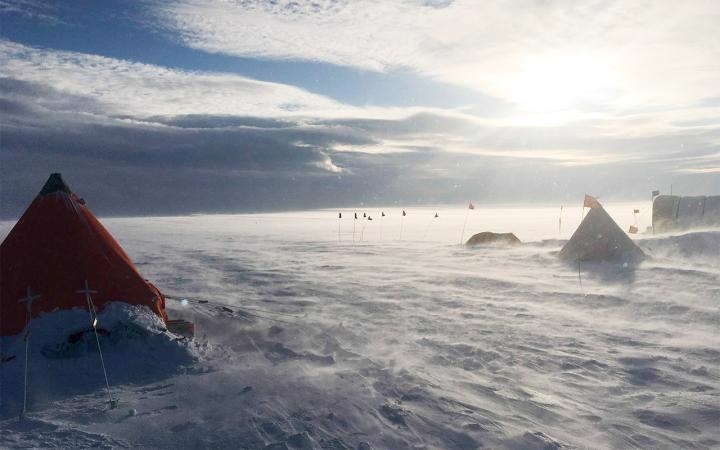Mar 3 2021
Researchers used NASA’s ice-measuring laser satellite to determine that atmospheric river storms are the main driver of elevated snowfall levels in West Antarctica during the austral winter in 2019.
 Thwaites Glacier in 2019. Image Credit: Kiya Riverman.
Thwaites Glacier in 2019. Image Credit: Kiya Riverman.
The results of the study, which was published recently in the Geophysical Research Letters journal, achieved by researchers from Scripps Institution of Oceanography at the University of California San Diego and their collaborators will help enhance the comprehensive knowledge of the processes forcing change in Antarctica and result in improved predictions of sea-level rise.
The research was financially supported by NASA, with further support from the Rhodium Group’s Climate Impact Laboratory, a consortium of leading research institutions analyzing the threats of climate change.
Atmospheric rivers are considered as phenomena that transfer huge amounts of water vapor in long and narrow “rivers” in the sky. They are well-known to be the principal driver of precipitation along the West Coast of the United States, contributing to 25% to 50% of yearly precipitation in main parts of the West.
More and more studies on atmospheric rivers have identified that they dominantly affect the western coasts of the majority of continents, as a result of ocean evaporation and storms adding high levels of moisture into the air.
NASA’s Ice, cloud, and land Elevation Satellite-2 (ICESat-2), which was launched into orbit in September 2018, has offered an elaborate look at the height of snow and ice on the vast, frozen continent.
The satellite functions by transmitting 10,000 laser pulses per second to the surface of the Earth, which help quantify the height of glaciers, ice sheets, and more by estimating the time taken by a handful of such pulses to return back to the satellite.
Every photon of light consists of a time tag, and these tags merge with the GPS location to spot its accurate position and height on the ground. It quantifies an elaborate set of tracks over the Antarctic ice sheet once in every three months.
ICESat-2 is the first satellite to be able to measure snowfall over the Antarctic continent in such a precise way. In winter, weather conditions prohibit having a field team there making observations on the ground. ICESat-2 is filling in this lack of data over the vast ice sheets, and giving us a greater understanding of snow mass gain and loss on a seasonal scale.
Helen Amanda Fricker, Study Co-Author and Glaciologist, Scripps Oceanography
Through the analysis of the ICESat-2 data, researchers discovered rise in height over the Antarctic Ice Sheet between April 2019 and June 2020 as a result of elevated levels of snowfall. They used a computational model of the snow and atmosphere to determine that the height increased by 41% over West Antarctica during the 2019 winter since intermittent extreme precipitation events provided huge quantities of snow during short periods.
Among such events, 63% were determined as landfalling atmospheric rivers. Such systems were differentiated from other storms by the considerably higher moisture levels that have been quantified in the atmosphere’s lower parts.
The atmospheric rivers that make landfall in Antarctica arise in the sub-tropical, mid-latitudes of the Southern Hemisphere. They travel long distances without disturbance from any continent, ultimately making landfall in West Antarctica.
We know the frequency of atmospheric rivers is expected to increase, so it’s important that scientists are able to measure how much they are contributing to snow mass increase or surface melting. Knowing how much snow is being accumulated across the continent helps us better understand how mass is changing as a whole, and informs our understanding of sea-level rise potential from the Antarctic Ice Sheet.
Susheel Adusumilli, Study Lead Author and PhD Candidate, Scripps Oceanography, University of California - San Diego
Annually, over 100 gigatons of ice are being lost to the ocean from Antarctica, contributing to continuing increase in the sea level. A majority of this ice loss has been forced by increased ice flow into the ocean caused by the melting of the floating ice shelves around Antarctica.
Gaining insights into the balance of mass gains from snowfall in the inner areas of Antarctica and mass loss from ocean warming is essential to enhance sea-level rise predictions.
Although this study had the potential to track ice mass in a short period of time, atmospheric rivers in Antarctica can also force huge amounts of snowmelt. Indeed, this study discovered that nearly 10% of winter atmospheric rivers and 90% of summer atmospheric rivers corresponded with possible surface melt over the West Antarctic Ice Sheet.
Atmospheric river-driven melting is caused as a result of the low clouds from such systems, which have the potential to absorb and re-discharge heat back to the surface. Researchers will need additional studies to comprehend whether such events will be melters or snowmakers, analyzing factors like moisture level, cloud coverage, seasonality, or whether each is storm-dependent.
In the U.S., scientists study atmospheric rivers and look at if they might be beneficial for water supply in California or hazardous, causing flooding. What’s interesting in Antarctica is the question, are atmospheric rivers going to contribute to snowmelt or snow accumulation?
Meredith Fish, Study Co-Author and Postdoctoral Associate, Rutgers University
Fish is an alumna of Scripps Oceanography, where she studied at the Center for Western Weather and Water Extremes.
Journal Reference:
Adusumilli, S., et al. (2021) Atmospheric River Precipitation Contributed to Rapid Increases in Surface Height of the West Antarctic Ice Sheet in 2019. Geophysical Research Letters. doi.org/10.1029/2020GL091076.